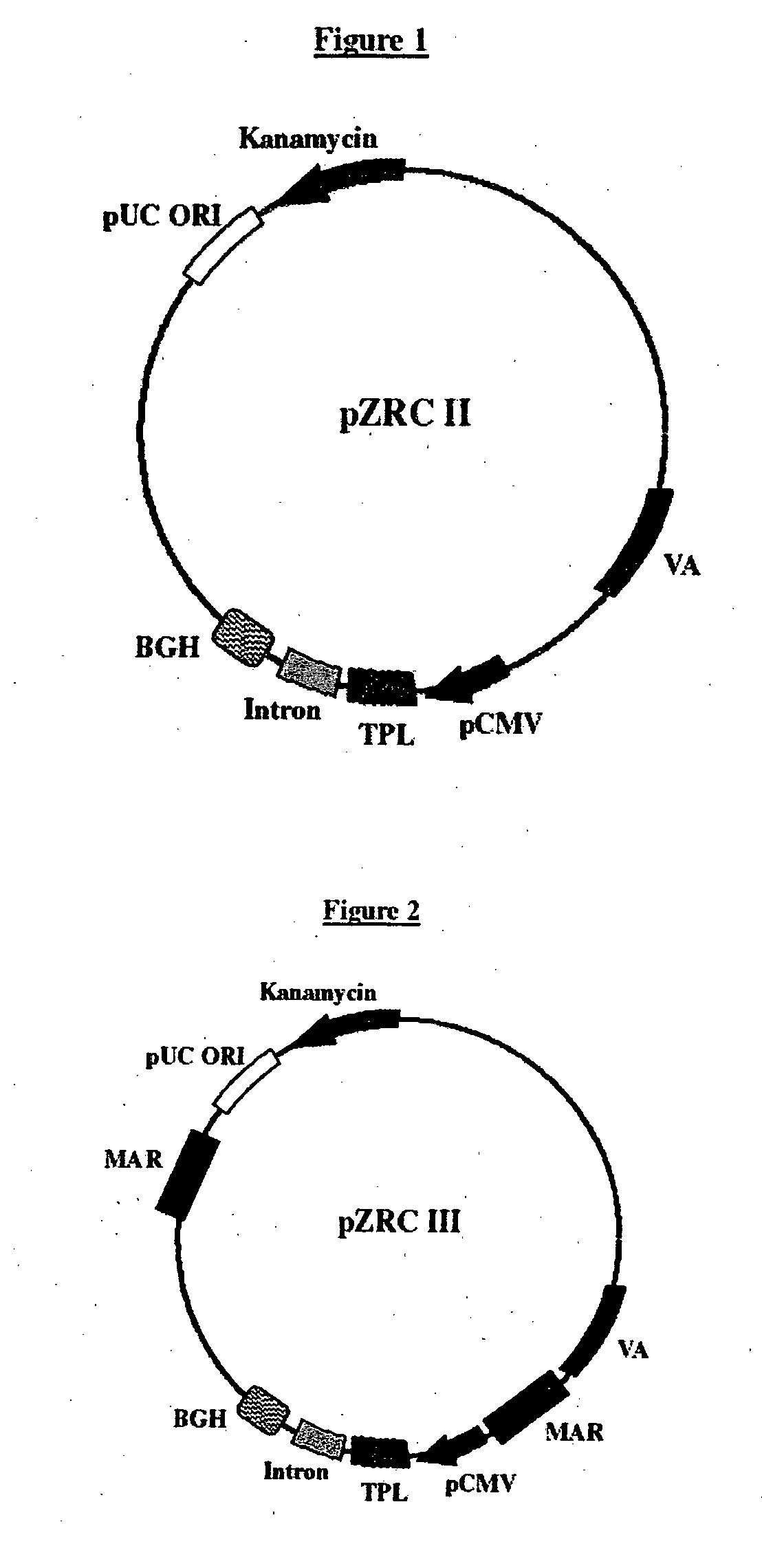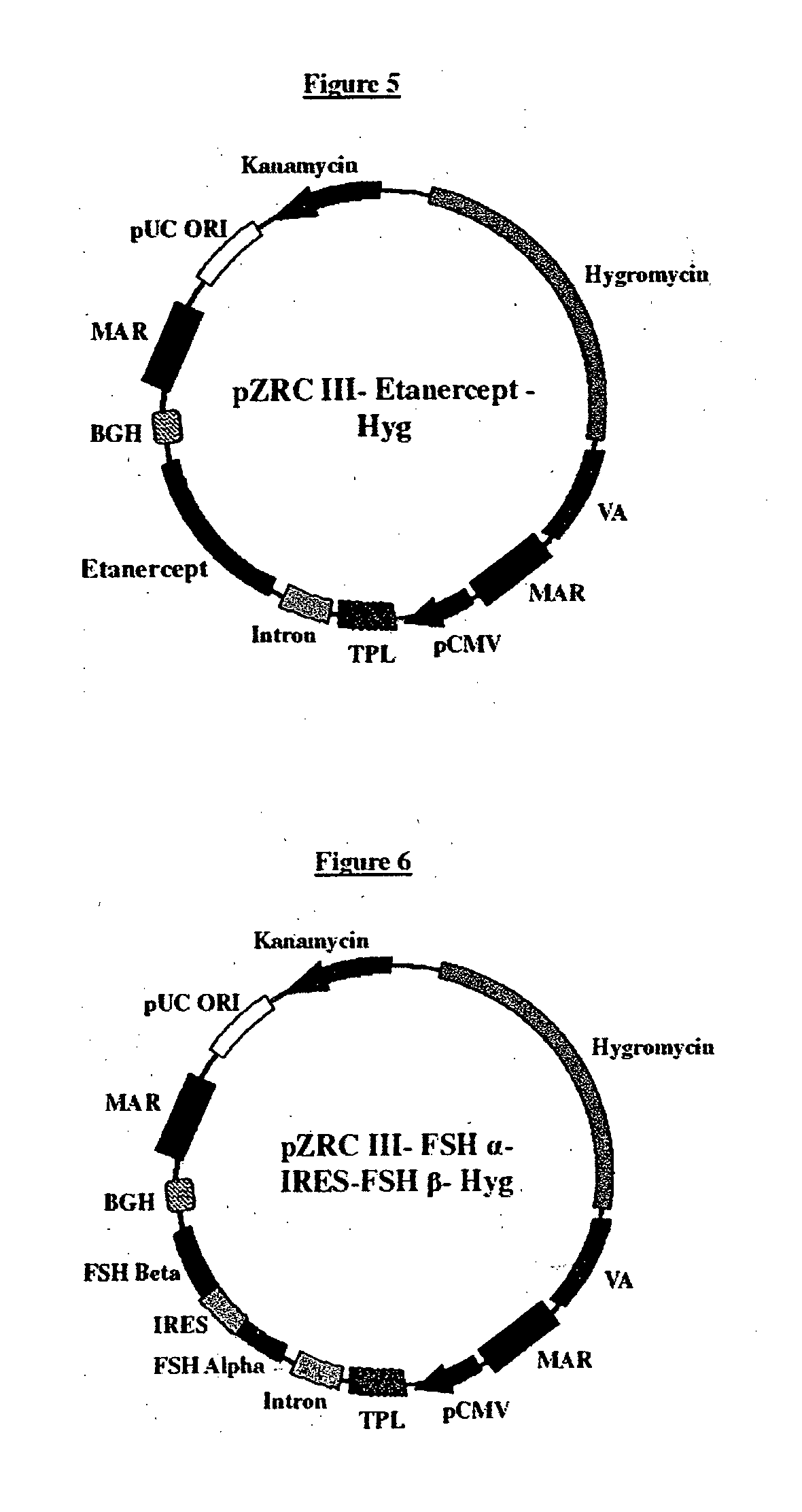Expression vector for high level expression of recombinant proteins
- Summary
- Abstract
- Description
- Claims
- Application Information
AI Technical Summary
Benefits of technology
Problems solved by technology
Method used
Image
Examples
example 1
Construction of pZRC III Vector
[0071]The whole transcription assembly with all the regulatory elements namely TPL, VA, CMV promoter, chimeric intron, and BGH polyadenylation and termination sequences, described in our earlier patent application WO2007017903, was chemically synthesized at GeneART, Germany. This whole assembly cloned in the cloning vector pMK (GeneART, Germany) was called pZRC II (FIG. 1, Seq ID No. 4,). Chicken lysozyme MAR DNA fragment (Seq ID No 5), (Phi-Van, L. and Stratling, W. H; Biochemistry 35 (33), 10735-10742 (1996)) was chemically synthesized and cloned in a cloning vector. Two chicken lysozyme MAR fragments were inserted as flanks on either side of the expression cassette in the pZRC II vector using the SacI and MluI sites which were already pre-designed into the vector. SacI overhang was added to the Chicken lysozyme MAR fragment by PCR using primers having SacI site. Specifically 40 cycles of PCR amplification were carried out using 100 picomoles of gene...
example 2
Construction of pZRC III-TNK Vector
[0073]Tenecteplase (TNKase or TNK-TPA) gene (Seq ID No 7) was chemically synthesized and cloned into a cloning vector pMK (Geneart, Germany). To clone TNK gene in the pZRC II vector, first EcoR I and Not I overhangs were incorporated into the TNK gene using 40 cycles of PCR amplification using 100 picomoles of specific oligonucleotide primers containing the above restriction sites in a volume of 50 μl containing 50 mM Tris-Cl (pH8.3), 2.5 mM MgCl2, 250 μM each of the 4 dNTPs and 5 units of Pfu Polymerase. Each PCR amplification cycle consisted of incubations at 95° C. for 30 sec (denaturation), 60° C. for 45 sec (annealing) and 72° C. for 2 min (extension). Amplified product of the PCR reaction was resolved on a 1% Agarose gel. The desired fragment of approx 1710 base pairs in size was excised out from the gel and purified using Qiagen Gel extraction kit. This purified DNA fragment of TNK was digested with EcoR I and Not I and ligated into pZRC III...
example 3
Construction of pZRC 1H-TNK-Hyg Vector
[0074]The Hygromycin transcription assembly of approx 1550 base pairs size and having the SV40 Promoter and terminator controlled Hygromycin resistance gene was blunt ended using Pfu polymerase (MBI Fermentas, USA) and then ligated into pZRC III-TNK vector, which was previously digested with Kpn I (MBI Fermentas, USA) and blunted using Pfu polymerase. The ligation product was transformed in E. coli Top 10F′ and transformants were scored on the basis of kanamycin resistance. Plasmid DNA isolated from few such colonies was analyzed for the presence of Hygromycin resistance gene by restriction digestion using various restriction enzymes. One such plasmid having the Hygromycin transcription assembly integrated in pZRC III-TNK vector was named, pZRC III-TNK-Hyg vector (FIG. 3, Seq ID No. 8). This vector was then subjected to DNA sequencing using automated DNA sequencer (ABI) to verify the sequence of the cloned TNK gene.
PUM
| Property | Measurement | Unit |
|---|---|---|
| Magnetic field | aaaaa | aaaaa |
| Antimicrobial properties | aaaaa | aaaaa |
Abstract
Description
Claims
Application Information
 Login to View More
Login to View More - R&D
- Intellectual Property
- Life Sciences
- Materials
- Tech Scout
- Unparalleled Data Quality
- Higher Quality Content
- 60% Fewer Hallucinations
Browse by: Latest US Patents, China's latest patents, Technical Efficacy Thesaurus, Application Domain, Technology Topic, Popular Technical Reports.
© 2025 PatSnap. All rights reserved.Legal|Privacy policy|Modern Slavery Act Transparency Statement|Sitemap|About US| Contact US: help@patsnap.com



